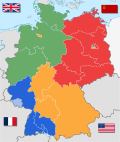Forbidden trains
Script error: No such module "Draft topics". Script error: No such module "AfC topic".
Forbidden trains (German: Verbotene Züge) – the popular term for the network of passenger railway connections of the occupying forces in Germany from the end of World War II to 1994, inaccessible to Germans.
The maintenance of large military forces by the Soviet Union, the United States, the United Kingdom, and France in the defeated country also generated significant transport needs, e.g. the need to maintain permanent and efficient connections with the countries that were their base. Particularly specific were the needs of the countries that occupied West Berlin, maintaining connections only with this city. The rolling stock used, especially in the first period, was requisitioned by the German Railways (Deutsche Reichsbahn).[1][2]
United States[edit]
Until 1947 the US Transportcorps RTO operated the connection between Bremerhaven via Helmstedt, Marienborn, Potsdam-Stadt, Griebnitzsee and the Berlin-Wannsee freight station, in the following years with the Berlin-Lichterfelde West station. The last train left in the summer of 1993.[3]
Great Britain[edit]
From 1945 the Royal Corps of Transport maintained a link linking Emden, Hannover Hbf., Helmstedt, Marienborn, Potsdam-Stadt, Griebnitzsee with Berlin-Charlottenburg. The most famous was the "Berliner" train No. D 1045/1046, on the Hannover–Berlin route. The last train left in May 1991.[4]
France[edit]
French Armed Forces Train (TMFB) No. D 1040/1041 ran between Paris and Strasbourg via Helmstedt, Marienborn, Potsdam-Stadt, Griebnitzsee with Berlin-Tegel (Gare Francaise). It consisted of sleeping cars, couchette cars, restaurant cars and lounge cars. For many years, the locomotive was replaced at Berlin-Wannsee station. The train arrived at Berlin-Tegel in the morning and departed in the evening, the last one on September 24, 1994.[5]
The Soviet Union[edit]
For communication in the years 1945–1949 in the Soviet Occupation Zone, the department was responsible, then the Transport Directorate of the Soviet Military Administration in Germany (Sowjetische Militäradministration in Deutschland – SMAD) based in Karlshorst, then the Group of Soviet Forces in Germany (Gruppe der sowjetischen Streitkräfte in Deutschland – GSSD) in Wünsdorf.[6][7]
In 1945–1994 the most important connection for the USSR was the line connecting Moscow via Brest Central and Berlin with Wünsdorf, the headquarters of the Group of Soviet Forces. From 1945 to the end of 1951, the connection between Moscow and Potsdam via Brest and Frankfurt (Oder) bypassed the sectors of West Berlin, because during this period the SMAD Command was located in Potsdam Babelsberg. Sometimes a train (No. D 1190/1191) ran from Brest via Frankfurt (Oder) and Mittenwalde to Wünsdorf, with a group of wagons from Frankfurt (Oder) via Jüterbog to Magdeburg. One more train ran between Brest and Erfurt (D 1192/1193) via Jüterbog, Halle/Saale and Sangerhausen, between Brest and Magdeburg – train (D 1194/1195). A group of wagons ran from Frankfurt (Oder) to Schwerin for many years as a train.[8][9]
Below is the list of trains:
- No. D 1190/1191 from Moscow to Wünsdorf via Frankfurt (Oder), Berlin-Köpenick, Berlin-Ostbahnhof (Hauptbahnhof) and Berlin-Schönefeld,
- D 1192/1193 from Brest to Erfurt, from Frankfurt (Oder) via Berlin-Köpenick, Berlin outer ring (Berliner Außenring), Genshagener Heide, Jüterbog, Holzdorf, Abzweig Großrössen, Beyern, Lutherstadt-Wittenberg, Dessau, Bitterfeld, Halle/Saale, Lutherstadt-Eisleben, Blankenheim Trennung and Sangerhausen,
- D 1194/1195 from Brest to Magdeburg, via Frankfurt (Oder), Berlin-Köpenick, Berlin-Schönefeld and Werder (Havel),
- D 1196/1197 from Brześć to Schwerin, from Frankfurt (Oder) via Eberswalde, Templin and Neustrelitz (in later years as a group of wagons attached to passenger trains),
- D 1198/1199 from Moscow to Wünsdorf via Frankfurt (Oder), Berlin-Köpenick, Berlin-Ostbahnhof (Hauptbahnhof) and Berlin-Schönefeld.
The last train in these relations left on September 1, 1994.[10][11]
References[edit]
- ↑ Я. Фойтцик, А. В. Доронин, Т. В. Царевская-Дякина: Советская военная администрация в Германии, 1945–1949. Справочник, РОССПЭН Moskwa 2009
- ↑ "Die Militärzüge der Siegermächte in Deutschland".
- ↑ "Die Militärzüge der Siegermächte in Deutschland".
- ↑ "Die Militärzüge der Siegermächte in Deutschland".
- ↑ "Die Militärzüge der Siegermächte in Deutschland".
- ↑ Я. Фойтцик, А. В. Доронин, Т. В. Царевская-Дякина: Советская военная администрация в Германии, 1945–1949. Справочник, РОССПЭН Moskwa 2009
- ↑ "Die Militärzüge der Siegermächte in Deutschland".
- ↑ Я. Фойтцик, А. В. Доронин, Т. В. Царевская-Дякина: Советская военная администрация в Германии, 1945–1949. Справочник, РОССПЭН Moskwa 2009
- ↑ "Die Militärzüge der Siegermächte in Deutschland".
- ↑ Я. Фойтцик, А. В. Доронин, Т. В. Царевская-Дякина: Советская военная администрация в Германии, 1945–1949. Справочник, РОССПЭН Moskwa 2009
- ↑ "Die Militärzüge der Siegermächte in Deutschland".
This article "Forbidden trains" is from Wikipedia. The list of its authors can be seen in its historical and/or the page Edithistory:Forbidden trains. Articles copied from Draft Namespace on Wikipedia could be seen on the Draft Namespace of Wikipedia and not main one.
- Soviet occupation zone
- American military occupations
- British military occupations
- French military occupations
- 1940s in East Germany
- Foreign relations of the Soviet Union
- World War II occupied territories
- Aftermath of World War II in Germany
- Allied occupation of Germany
- Soviet military occupations
- Germany–Soviet Union relations
- States and territories established in 1945
- States and territories disestablished in 1949
- 1945 in Germany
- 1945 establishments in Europe
- 1949 disestablishments in Europe


